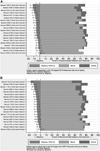Measuring racial disparities in the quality of ambulatory diabetes care
- PMID: 21063231
- PMCID: PMC3005338
- DOI: 10.1097/MLR.0b013e3181f37fcf
Measuring racial disparities in the quality of ambulatory diabetes care
Abstract
Background: Improving the health of minority patients who have diabetes depends in part on improving quality and reducing disparities in ambulatory care. It has been difficult to measure these components at the level of actionable units.
Objective: To measure ambulatory care quality and racial disparities in diabetes care across groups of physicians who care for populations of ambulatory diabetes patients.
Research design: Prospective cohort analysis using administrative data.
Subjects: Using fee-for-service Medicare claims data from 2003 to 2005, we link patients to their principal ambulatory care physician. The patients are then linked to the hospital where their physicians work or have their patients admitted, creating physician-hospital networks.
Measures: Proportion of recommended diabetes testing received by black and nonblack diabetes patients.
Results: Blacks received 70% of recommended care compared with nonblacks who received 76.9% (P < 0.001). However, for black and nonblack patients, variation in the quality of care exceeds the racial gap in treatment. The network-specific performance rates for blacks and nonblacks were highly correlated (r = 0.67, P < 0.001), but 47% of blacks, versus 31% of nonblacks, received care from the third of networks with lowest quality. Physician-hospital networks with higher overall quality, or patients with higher socioeconomic status, were no less likely to exhibit black-white disparities.
Conclusions: It is possible to measure, benchmark, and monitor the quality of minority care at the level of networks responsible for ambulatory care. Consequently, it should be easier to provide patients with information on network performance and to design policies that improve the quality of minority-serving providers.
Figures



Similar articles
-
Physician performance and racial disparities in diabetes mellitus care.Arch Intern Med. 2008 Jun 9;168(11):1145-51. doi: 10.1001/archinte.168.11.1145. Arch Intern Med. 2008. PMID: 18541821
-
Trends in the quality of care and racial disparities in Medicare managed care.N Engl J Med. 2005 Aug 18;353(7):692-700. doi: 10.1056/NEJMsa051207. N Engl J Med. 2005. PMID: 16107622
-
Quality of care and racial disparities in medicare among potential ACOs.J Gen Intern Med. 2014 Sep;29(9):1296-304. doi: 10.1007/s11606-014-2900-3. Epub 2014 May 31. J Gen Intern Med. 2014. PMID: 24879050 Free PMC article. Clinical Trial.
-
Mortality Disparities in Racial/Ethnic Minority Groups in the Veterans Health Administration: An Evidence Review and Map.Am J Public Health. 2018 Mar;108(3):e1-e11. doi: 10.2105/AJPH.2017.304246. Am J Public Health. 2018. PMID: 29412713 Free PMC article. Review.
-
Promises and Perils of Group Clinics for Young People Living With Diabetes: A Realist Review.Diabetes Care. 2019 May;42(5):705-712. doi: 10.2337/dc18-2005. Diabetes Care. 2019. PMID: 31010940 Review.
Cited by
-
Proportion of Racial Minority Patients and Patients With Low Socioeconomic Status Cared for by Physician Groups After Joining Accountable Care Organizations.JAMA Netw Open. 2020 May 1;3(5):e204439. doi: 10.1001/jamanetworkopen.2020.4439. JAMA Netw Open. 2020. PMID: 32383749 Free PMC article.
-
Rational use of electronic health records for diabetes population management.Curr Diab Rep. 2014 Apr;14(4):479. doi: 10.1007/s11892-014-0479-z. Curr Diab Rep. 2014. PMID: 24615333 Review.
-
Disparities in Diabetes Care Quality by English Language Preference in Community Health Centers.Health Serv Res. 2018 Feb;53(1):509-531. doi: 10.1111/1475-6773.12590. Epub 2016 Oct 21. Health Serv Res. 2018. PMID: 27767205 Free PMC article.
-
Challenges To Reducing Discrimination And Health Inequity Through Existing Civil Rights Laws.Health Aff (Millwood). 2017 Jun 1;36(6):1041-1047. doi: 10.1377/hlthaff.2016.1091. Health Aff (Millwood). 2017. PMID: 28583962 Free PMC article.
-
Evaluating the Effect of Medicaid Expansion on Black/White Breast Cancer Mortality Disparities: A Difference-in-Difference Analysis.JCO Glob Oncol. 2020 Jul;6:1178-1183. doi: 10.1200/GO.20.00068. JCO Glob Oncol. 2020. PMID: 32721196 Free PMC article.
References
-
- Institute of Medicine. Unequal Treatment: Confronting Racial and Ethnic Disparities in Health Care. Washington, DC: National Academy Press; 2002. - PubMed
-
- Baicker K, Chandra A, Skinner JS. Geographic variation in health care and the problem of measuring racial disparities. Perspect Biol Med. 2005;48 suppl 1:S42–S53. - PubMed
-
- Trivedi AN, Zaslavsky AM, Schneider EC, et al. Trends in the quality of care and racial disparities in Medicare managed care. N Engl J Med. 2005;353:692–700. - PubMed
-
- Trivedi AN, Zaslavsky AM, Schneider EC, et al. Relationship between quality of care and racial disparities in Medicare health plans. JAMA. 2006;296:1998–2004. - PubMed
Publication types
MeSH terms
Grants and funding
LinkOut - more resources
Full Text Sources
Medical
Miscellaneous

